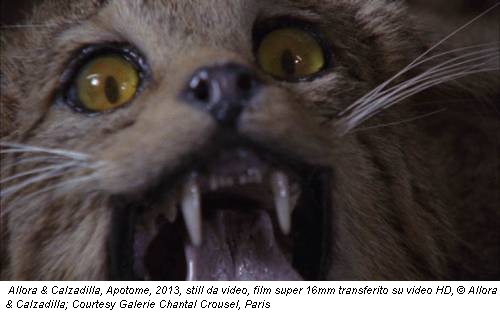Allora & Calzadilla – Fault Lines

Le Fault Lines diventano punto di partenza per un’indagine del concetto di confine, di quelle linee fisiche e simboliche che separano due mondi, facendosi limite, demarcazione, catalizzatore di tensione.
Comunicato stampa
Le opere di Allora & Calzadilla nascono dalla combinazione sperimentale di elementi e linguaggi diversi – scultura, fotografia, performance, musica, suoni e video – alla ricerca del punto di incontro tra leggerezza e complessità da cui avventurarsi nell’esplorazione delle geografie psicologiche, politiche e sociali della cultura contemporanea globalizzata. Per loro l’arte è un pretesto per indagare concetti chiave del nostro presente, quali l’identità nazionalità, la democrazia, il potere, la libertà, la partecipazione e i cambiamenti sociali.
Da questo approccio nasce la scelta del titolo per la mostra con la Fondazione Nicola Trussardi: Fault Lines, letteralmente linee di faglia, quelle fratture del suolo che si formano nel punto di incontro tra due masse rocciose in movimento, linee frastagliate, instabili, che nascondono fragilità profonde, pronte ad arrivare da un momento all’altro al punto di rottura. In questo caso le Fault Lines diventano punto di partenza per un’indagine del concetto di confine, di quelle linee fisiche e simboliche che separano due mondi, facendosi limite, demarcazione, catalizzatore di tensione.
Come etnografi post-coloniali, Allora & Calzadilla scandagliano limiti e contraddizioni del mondo globale, combinando nei loro lavori frammenti di una società in continua trasformazione di cui rileggono gli eventi per tracciare mappe e percorsi dove tempo e spazio si fondono in potenti metafore. Con un gioco di continue sovrapposizioni e sostituzioni, cambiamenti repentini e rotture, la coppia di artisti compone un mosaico di geografie instabili ed equilibri precari contemporaneamente paradossali e rivelatori, in cui il corpo è terreno di confronto, di scontro, di scambio di energia, e lo strumento con cui connettersi al resto del mondo.
Nei magnifici spazi di Palazzo Cusani Allora & Calzadilla presentano un’imponente selezione di lavori recenti, per lo più inediti in Italia, e nuove produzioni realizzate appositamente per la mostra. Dal maestoso Salone Radetzky – la sala da ballo con stucchi e affreschi originali intitolata al generale austriaco che nel Palazzo ebbe il suo quartier generale fino alle Cinque Giornate di Milano – alla Sala delle Allegorie – con i suoi dipinti e soffitti affrescati raffiguranti scene e simboli della mitologia greca – si susseguono sculture sonore, performance, video e immagini che si intrecciano con la storia del luogo e con la cronaca dei nostri giorni, destabilizzandole e riordinandole secondo un ritmo narrativo che alterna sorpresa, poesia, umorismo ed epifanie.
Allora & Calzadilla trasformano le sontuose sale barocche del Palazzo in un variopinto carillon in cui si muovono trombettisti indiavolati, pianisti intrappolati nei loro strumenti musicali, soprani e tenori rinchiusi in grandi bozzoli di poliuretano, ballerini che marciano trasformandosi in porte, dando vita a un percorso in cui suoni e musica diventano metafore di rapporti di forza, conquista, resistenza e seduzione. Per l’opera Stop, Repair, Prepare, ad esempio, gli artisti hanno modificato un pianoforte a coda, scavandovi un buco circolare: ogni ora, un pianista in piedi al centro del piano, da dietro la tastiera tenta di suonare il quarto movimento della Nona Sinfonia di Beethoven. Comunemente conosciuto come Inno alla gioia, questo famoso coro finale è da sempre evocato come una rappresentazione musicale della fraternità umana e della fratellanza universale, usato come inno nei contesti ideologicamente più disparati, dalla Comunità europea alla Rivoluzione Culturale cinese, dalla Rhodesia sostenitrice della supremazia bianca al Terzo Reich, per citarne solo alcuni.
Sediments, Sentiments, invece, è un’imponente scultura in poliuretano dal cui interno cantanti lirici interpretano frammenti dei più importanti discorsi ufficiali pronunciati dai protagonisti della storia del XX° secolo – da Martin Luther King a Nikita Khrushchev, dal Dalai Lama a Saddam Hussein – smontandone il linguaggio retorico e smascherandone gli artifici.
Cuore della mostra – accanto a due installazioni appositamente pensate per gli spazi di Palazzo Cusani – è la nuova trilogia di film appena realizzata da Allora & Calzadilla per il Festival d’Automne à Paris e presentata in anteprima assoluta in Italia, in cui gli artisti indagano la storia della musica e in particolare il legame tra le nostre culture primitive, le nostre origini e la funzione del suono. Come in un vero e proprio esperimento di etnomusicologia contemporanea, Raptor’s Rapture, esposto lo scorso anno a Documenta a Kassel, Apotome e 3 studiano i modi in cui la musica e i suoni possono trasformarsi in portatori di leggende, miti e valori, diventando al tempo stesso strumento per conoscere noi stessi, la nostra storia, e tracciare le basi per un cambiamento futuro.
view image gallery
Palazzo Cusani è una residenza privata nobiliare barocca situata in via Brera 13-15, nel cuore di Milano, costruita su progetto dell'architetto Giovanni Ruggeri all'inizio del XVII° secolo e poi rinnovato tra il 1775 e il 1779 da Giuseppe Piermarini, con una nuova facciata neoclassica interna.Nel 1808 il Palazzo fu venduto da Luigi Cusani al Regno d'Italia e da allora l’edificio è stato sede del Ministero della Guerra durante l’occupazione napoleonica e quella austriaca, per poi diventare una delle sedi dell'Esercito Italiano.
Palazzo Cusani conserva ancora intatti in tutto il loro fascino gli stucchi e gli affreschi tardo barocchi e la sua magnifica sala da ballo – ormai comunemente soprannominata Salone Radetzky, intitolato al generale austriaco che ispirò a Johann Strauss padre l’omonima marcia e che nel Palazzo ebbe il suo quartier generale fino alle 5 Giornate di Milano – mentre la maggior parte degli arredi originali sono andati persi.Per più di due secoli, in particolare durante la proprietà della famiglia Cusani e con la presenza di Ferdinando Cusani (1737-1815), il palazzo è stato al centro della vita sociale d'élite della città, ospitando ricevimenti indimenticabili e sontuose feste nel suo splendido giardino. Particolarmente drammatico fu, invece, nell’agosto del 1943, il bombardamento alleato che danneggiò seriamente il Palazzo pur non abbattendolo, come avvenne invece per l’adiacente chiesa di Sant’Eusebio e per altri palazzi storici lì accanto. Durante i mesi successivi alla Liberazione vi si stabilì il Comando generale del Corpo Volontari della Libertà agli ordini del generale Raffaele Cadorna.
Oggi Palazzo Cusani è sede del Comando Militare Territoriale di Milano e del Circolo Ufficiali di Presidio dell’Esercito, oltre che del Comando del Corpo d’Armata di Reazione Rapida della Nato.Dopo essere rimasto chiuso al pubblico per molti anni, Palazzo Cusani ospiterà per la prima volta nella sua storia una mostra d'arte contemporanea, grazie alla collaborazione con il Comando Militare Esercito Lombardia.
Jennifer Allora è nata a Filadelfia (USA), nel 1974. Guillermo Calzadilla è nato a La Havana (Cuba), nel 1971. Si sono incontrati durante un viaggio di studio a Firenze e hanno iniziato a collaborare nel 1995. Vivono e lavorano a San Juan, Portorico (USA).
Parallelamente agli studi all’Università di Richmond, un Master in Scienze al Massachusetts Institute of Technology e una borsa di studio all’Art Independent Study Program del Whitney Museum per Jennifer Allora, e agli studi alla Escuela de Artes Plásticas a San Juan e un Master al Bard College per Guillermo Calzadilla, la coppia ha intrapreso una carriera artistica che li ha portati a esporre nei più importanti musei del mondo. Nel 2004 hanno vinto il Gwangju Biennale Prize indetto dall’omonima Biennale in Corea, mentre nel 2006 sono stati finalisti dell’Hugo Boss Prize del Guggenheim Museum di New York e del Nam June Paik Award di Dusseldorf. Nel 2010 sono stati finalisti per il 4th Plinth Commission, per la realizzazione di una scultura temporanea a Trafalgar Square, a Londra.
I loro video, le loro installazioni, sculture e performance sono stati esposti in mostre personali nelle principali istituzioni internazionali, tra cui l’Indianapolis Museum of Art (2012), il Castello di Rivoli (2011), il Museum of Modern Art di New York (2010), il National Museum of Art, Architecture, and Design di Oslo (2009), il Kunstmuseum Krefeld (2009), l’Haus der Kunst di Munich (2008), la Kunstverein Munich (2008), lo Stedeliijk Museum di Amsterdam (2008), la Kunsthalle di Zurigo (2007), la Serpentine Gallery di Londra (2007), la Renaissance Society di Chicago (2007), la Whitechapel Gallery di Londra (2007), il Palais de Tokyo di Parigi (2006), lo S.M.A.K- Stedelijk Museum voor Actuele Kunst di Ghent (2006), il Dallas Museum of Art (2006). Hanno preso parte alle maggiori kermesse internazionali, tra cui Documenta a Kassel (2011), la Biennale di Venezia (2011, 2005), la Biennale di San Paolo a San Paolo del Brasile (2011, 1998), Performa a New York (2009), la Biennale di Gwangju in Corea (2008, 2006), la Biennale di Lione (2007, 2005), la Biennale di Istanbul (2007), la Biennale di Sharjah (2007), la Biennale di Mosca (2007, 2005) e la Biennale del Whitney Museum di New York (2006).
Nel 2011 hanno rappresentato gli Stati Uniti d’America alla 54. Esposizione Internazionale d’Arte della Biennale di Venezia. Fault Lines con la Fondazione Nicola Trussardi è la loro prima grande mostra personale in un’istituzione italiana, e la più grande mostra personale che abbiano mai realizzato.
Allora & Calzadilla have developed an experimental and interdisciplinary body of work, linking different elements and languages—such as sculpture, photography, performance, music, sound, and video—which are combined to explore the psychological, political, and social geography of contemporary globalized culture. Their practice investigates pivotal concepts of our time such as nationalism, power, freedom, participation, and social change.
This approach is what inspired the title for their exhibition with the Fondazione Nicola Trussardi: Fault Lines, the rifts in the earth that form between two shifting masses of rock; ragged, unstable fissures that conceal a deep fragility, and could reach the breaking point at any moment. In Allora and Calzadilla's work, these Fault Lines are taken as points of departure for an exploration of physical and symbolic borders and junctures.
In the magnificent spaces of Palazzo Cusani Allora & Calzadilla presents an impressive selection of recent work, most of it never previously shown before in Italy, as well as new pieces created specifically for the show. From the majestic Radetzky Hall—a ballroom with its original stucco and frescoes, named after the Austrian general who had his headquarters in the palazzo until the Milan uprising—to the Hall of Allegories—with paintings and frescoed ceilings depicting scenes and symbols from Greek mythology—we encounter a succession of sounds, sculptures, performances, videos, and images that intertwine with the history of the site and the story of our times, disrupting them only to piece them back together with a narrative rhythm that alternates surprise, poetry, humor and epiphany.
Allora & Calzadilla transform the sumptuous Baroque rooms of the Palazzo into a many-hued music box peopled by trumpet players turning steps into musical scales, pianists trapped inside their instruments, sopranos and tenors enveloped in tunnel-like passageways, and marching dancers acting as doors, creating an experience in which sound and music become metaphors for the dynamics of power, conquest, resistance, and seduction.
For Stop, Repair, Prepare, for instance, the artists have modified a grand piano by carving a circular hole in it; once an hour, a pianist standing in the void, behind the keyboard, attempts to play the fourth movement of Beethoven’s Ninth Symphony. Commonly known as the Ode to Joy, this famous final chorus has long been invoked as a musical representation of human fraternity and universal brotherhood in contexts as ideologically disparate as the European Union, the Chinese Cultural Revolution, white-supremacist Rhodesia, and the Third Reich among many others. In Stop, Repair, Prepare, a structurally incomplete version of the ode creates variations on the corporeal as well as sonic dimension of the player/instrument dynamic, the signature melody, and its pre-established connotations.
Sediments, Sentiments (Figures of Speech), on the other hand, is an imposing polyurethane and plaster sculpture inside which opera singers perform passages from the most significant speeches of the twentieth century, from Martin Luther King to Nikita Khrushchev, and from the Dalai Lama to Saddam Hussein. With Sediments, Sentiments (Figures of Speech), rhetorical language is cracked open, dismantled, and reconfigured through the artificial diction of operatic form.
At the heart of the show—alongside two works made especially for Palazzo Cusani—is a new film trilogy which Allora & Calzadilla have just made for the Festival d’Automne à Paris and are presenting in its Italian premiere; in it, the artists explore the history of music, and specifically, its place in human evolution. Like a full-fledged experiment in contemporary ethnomusicology, Raptor’s Rapture, shown last year at Documenta in Kassel, Apotome and 3 examine how music has come to play such a central role in human culture, its affective and transformative power, and its potential to express ancient myths and foreground future changes.
view image gallery
Palazzo Cusani is a private aristocratic residence from the Baroque era located at 13-15 Via Brera in the heart of Milan. Designed by Giovanni Ruggeri and built in the early seventeenth century, it was renovated between 1775 and 1779 by Giuseppe Piermarini, with a new rear façade in Neoclassical style. In 1808, Luigi Cusani sold the palazzo to the Kingdom of Italy, and the building became the headquarters for the Ministry of War during both the Napoleonic and Austrian occupations, later becoming a base for the Italian Army. Palazzo Cusani can still boast perfectly preserved stuccoes and frescoes from the late Baroque era and a magnificent ballroom—now commonly referred to as the Radetzky Hall, after the Austrian general who inspired Johann Strauss the Elder to write the Radetzky March, and who had his headquarters here until the Milan uprising—whereas most of the original furnishings have been lost. For over two centuries, especially under the ownership of the Cusani family and during the life of Ferdinando Cusani (1737-1815), the palazzo was the hub of elite society life in the city, housing unforgettable receptions and sumptuous soirées in its gorgeous garden. A particularly dramatic chapter in its history, on the other hand, came in August 1943, with an Allied bombing that seriously damaged the palazzo, though without destroying it, as was instead the fate of the adjacent church of Sant’Eusebio and other nearby historic buildings. In the months after the liberation of Italy, the General Command of the “Volontari della Libertà” corps set up its headquarters here under General Raffaele Cadorna.
Today, Palazzo Cusani is the headquarters of the Local Military Command for Milan and the Army Officers’ Club, as well as the NATO Rapid Deployment Corps. After being closed to the public for many years, Palazzo Cusani will be housing a contemporary art exhibition for the first time in its history, through the collaboration of the Army Military Command for Lombardy.
Jennifer Allora was born in Philadelphia, USA in 1974. Guillermo Calzadilla was born in Havana, Cuba in 1971. They met on a study program in Florence and began collaborating in 1995. They live and work in San Juan, Puerto Rico.
Parallel to their studies—Jennifer Allora’s at the University of Richmond, with a MS from the Massachusetts Institute of Technology and a fellowship at the Whitney Museum of American Art Independent Study Program; Guillermo Calzadilla’s at the Escuela de Artes Plasticas in San Juan, with an MFA from Bard College—the couple embarked on an artistic career that has led them to exhibit in the world’s most important museums. In 2004 they won the Gwangju Biennale Prize in Korea, while in 2006 they were finalists for the Guggenheim’s Hugo Boss Prize in New York and the Nam June Paik Award in Dusseldorf. In 2010 they were shortlisted by the Fourth Plinth Commission to create a temporary sculpture for London’s Trafalgar Square.
Their videos, installations, sculptures and performances have been featured in solo exhibitions at the world’s most prominent institutions, including the Indianapolis Museum of Art (2012), Castello di Rivoli in Turin (2011), the Museum of Modern Art in New York (2010), The National Museum of Art, Architecture, and Design, Oslo (2009), the Kunstmuseum Krefeld (2009), Haus der Kunst in Munich (2008), the Kunstverein Munich (2008), the Stedeliijk Museum in Amsterdam (2008), the Kunsthalle in Zurich (2007), the Serpentine Gallery in London (2007), the Renaissance Society in Chicago (2007), Whitechapel Gallery in London (2007), the Palais de Tokyo in Paris (2006), S.M.A.K- Stedelijk Museum voor Actuele Kunst in Ghent (2006), and the Dallas Museum of Art (2006). They have taken part in leading international festivals such as Documenta in Kassel (2011), the Venice Biennale (2011, 2005), the São Paulo Biennial (2011, 1998), Performa in New York (2009), the Gwangju Biennale (2008, 2006), the Biennale de Lyon (2007, 2005), the Istanbul Biennial (2007), the Sharjah Biennial (2007), the Moscow Biennale (2007, 2005) and the Whitney Biennial in New York (2006).In 2011 they represented the United States of America at the 54th International Art Exhibition of the Venice Biennale. Fault Lines with the Fondazione Nicola Trussardi is their first major solo exhibition in Italy, and their biggest solo show to date.



